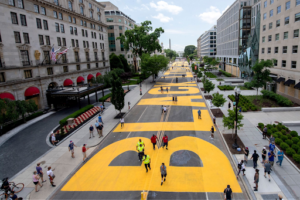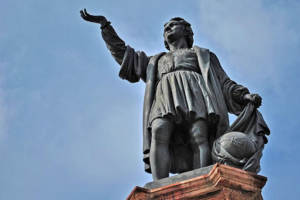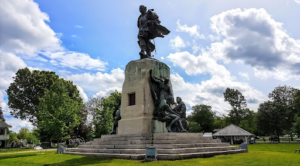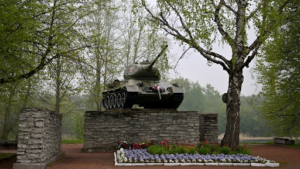Photo: Spencer McNeil (2021). “Chicago Monuments Project with Brendan Fernandes.” 2021. Chicago, Illinois. Permission to use. <https://spencermcneil.com/chicago-monuments-project>
By Gilbert C. Correa, Monuments Toolkit Project
Over the course of the past eleven months, the Monuments Toolkit Team has been analyzing and documenting monuments, as well as proactive approaches that have been used by stakeholders. The formation of working groups convened by local governments one method often met with success. Working groups are usually composed of government officials, academics, community leaders, and community members. This blog post shares the work of six working groups that have been proactive in their local communities to resolve controversial monuments in public spaces.
Monuments Working Group—Charlottesville, Virginia USA
Figure 1
The Robert E. Lee Statue Pedestal on Monument Avenue, Richmond, Virginia.
Note. By Martin Falbisoner, “Robert E. Lee Monument,”
Antonin Mercié, 1890.
The Monuments Working Group is based in Charlottesville, Virginia. It was founded in July 2018 a year after the Unite the Right Rally (August 11-12, 2017) by then doctoral student, Justin Greenlee, as a protest-based organization to counter white nationalist gatherings around Confederate monuments in Richmond, Virginia. Its mission is to act on behalf of social justice and remove the bigotry on display in our cities’ most revered public locations. The Monuments Working Group is a division of the Public Humanities Lab in the Institute for Humanities & Global Culture at the University of Virginia.
The Monuments Working Group’s primary activities occurred in the 2018–19 academic year which included, but not limited to: advocated for belated changes to the University of Virginia’s monumental landscape; campaigned to have all Confederate statues removed from Monument Avenue in Richmond; supported alternate forms of commemoration that acknowledge past acts of violence against African Americans and Indigenous peoples living in Charlottesville, Virginia; leveraged resources that could be distributed to ongoing, minority-led initiatives in Charlottesville and Richmond and; advocate for institutional and systemic change in the monumental and memorial landscape.
Some projects undertaken include, but not limited to: advocacy related to the need to rename the Barringer Wing in the West Complex of UVA Hospital; renaming of the the Boulevard in Richmond to Arthur Ashe Boulevard; removing the Lee statue and other Confederate monuments in Richmond and; the development of an undergraduate course at the University of Virginia for 2019 Summer Session (II) entitled “Monuments, Memorials, and UVa” (Monuments Working Group, 2021).
Click here to read about the Monuments Working Group’s projects
Chicago Monuments Project—Chicago, Illinois USA
Figure 2
The Bowman and the Spearman Monument in Grant Park, Chicago, Illinois.
Note. By Jyoti Srivastava, ”Indians (The Bowman and the Spearman),”
Ivan Mestrovic, 1928.
The Chicago Monuments Project is based in Chicago, Illinois. It was founded in the Summer of 2020 by the City of Chicago following the death of George Floyd to reckon with the exclusions and oversimplifications in public art collections. Its mission is to address the frequently overlooked – or forgotten – history connected to the City’s various municipal art collections. The Chicago Monuments Project is overseen by the Advisory Committee. The Advisory Committee is composed of local community leaders, artists, architects, academics, curators and city officials. This large coalition interacts with a variety of communities and viewpoints to raise issues and bring the viewpoints necessary to carry out this task on behalf of all Chicagoans.
The project has four primary goals: I) cataloging monuments and public artwork located on City or Park District property; II) appointing an advisory committee to determine which works require attention or action; III) formulating suggestions for new monuments or public artwork that could be commissioned and; IV) providing a forum for the general public to participate in a civic dialogue about Chicago’s history.
The Chicago Monuments Project chose 41 of 500 monuments for consideration that were produced between 1893 and the late 1930s. They have their roots in the World’s Columbian Exposition, which sent hundreds of sculptors, architects, and artisans to Chicago to create a representation of the city that reflected the prevailing culture of the day. The Exposition, also known as the “White City,” presented a highly idealized and orderly vision of Chicago in which traditional neo-classical architecture and sculpture were integrated into a well-kept, natural setting. This was in contrast to the harsh realities of living in a rapidly expanding 19th-century industrial metropolis. The structures and sculptures, which were made in a heroic size and were meant to overwhelm, paid homage to a concept of Progress and put the western tradition, western Europe, and America at the pinnacle of global civilization.
The Chicago Monuments Project conducted a lengthy public engagement process to acquire feedback like surveys, live conversations and a free-response public feedback form on the Project’s website. Key findings were the creation of new public artworks as well as continuous procedures and activities that will guarantee the telling of more inclusive stories. The next steps are to support the development of new public artworks; establish a public process for re-examining public monuments; specific treatment recommendations for monuments under review and; programmatic investments that will enhance the monuments in the Chicago’s collection (Chicago Monuments Project, pg. 5, 2021).
Click here to read the Chicago Monuments Project’s Report
District of Columbia Facilities and Commemorative Expressions Working Group (DCFACES)—Washington, District of Columbia USA
Figure 3
Black Lives Matter Plaza, Washington, District of Columbia USA

Note. By AJ Willingham, “Black Lives Matter Plaza,”
The Cable News Network (CNN), 5th June 2020.
The District of Columbia Facilities and Commemorative Expressions Working Group (DCFACES) is based in Washington, District of Columbia. It was founded in July of 2020 by Mayor Muriel Bowser to evaluate named government owned public spaces. The mission of the DCFACES Working Group is to make recommendations for remedial action like demolishing, renaming or contextualizing structures, areas or monuments. The DCFACES Working Group is overseen by three committees chaired by employees of District agencies: Engagement Committee is tasked with engaging the local community to obtain feedback; Policy Committee is tasked with examining and evaluating the procedures and guidelines for renaming and removing members and established the decision-making process and; Research Committee is tasked with gathering data on resources and people who are essential to decision-making.
The DCFACES Working Group also examined the legacy of 153 of 3,050 total assets’ namesakes to make sure that their personal and political philosophies do not contribute to the nation’s history of slavery, systemic racism and other biases, but rather focus on those that are in line with DC values of empowering and elevating people of color. Examples of assets examined include, but not limited to DC Government-owned: buildings like Francis Scott Key Hall; public schools like Alexander Graham Bell Vocational High School; parks like James Monroe Park and; campuses like Woodrow Wilson International Center for Scholars.
The DCFACES Working Group conducted an extensive public engagement process to acquire feedback via surveys, direct phone calls and town hall meetings. Key findings were the renaming of the namesakes of public spaces or commemorative works and; relocation of assets to a museum, park or other public space. The most cited public assets not in alignment with District values were Woodrow Wilson High School, Francis Griffith Newlands Memorial Fountain, the J. Edgar Hoover building, the Andrew Jackson Statue and the Emancipation Memorial (DCFACES Working Group Report, pg. 11, 2020).
Click here to read the DCFACES Working Group’s Report
Committee of Monuments and Artistic Works in Public Spaces of Mexico City (COMAEP)—Mexico City, Mexico
Figure 4
Statue of Christopher Columbus in Mexico City, Mexico

Note. By Gaceta UNAM, “Statue of Christopher Columbus,”
Gaceta UNAM, 3rd November 2020.
The Committee of Monuments and Artistic Works in Public Spaces of Mexico City (COMAEP) is based in Mexico City, Mexico. It was founded in 2013 by the Government of Mexico City and the Secretariat of Culture of Mexico City as a means to provide historic preservation consultation and advisory to the Head of the Government of Mexico City on matters related to permanent removal and relocation of public monuments. The mission of the Committee is the continued preservation of historical or artistic monuments, mural paintings, sculptures and any artistic work in public spaces. The Committee is composed of 15 prominent astute experts representing diverse disciplines, points of view and that have enriched the cultural life of the city.
The Head of Government, Claudia Sheinbaum, called upon the Committee for help after being notified of an activist-led organized demonstration to topple the statue of Christopher Columbus from the famous Paseo de la Reforma Avenue Glorieta de Colón (Spanish: Roundabout of Columbus) on 12th October 2020. The controversial statue of Christopher Colombus was removed two days earlier to protect its historical fabric. On the 25th September 2021, several feminist collectives and their relatives occupied the former Columbus roundabout and installed an antimonumenta, anti-monument built to demand justice for the nation’s femicide and gender violence victims. The collective symbolically called it the Glorieta de las mujeres que luchan (Spanish: Roundabout for the Women Who Fight) (Pacheco, 2021).
The Committee in collaboration with the National Institute of Anthropology and History, the National Institute of Fine Arts and Literature, the Cultural Advisory Council of Mexico City, the Secretariat of Culture of Mexico City and the Government of Mexico City shall replace the statue of Columbus with one of an Olmec woman called La Joven de Amajac (Spanish: the Young Woman of Amajac) on Indigenous Peoples Day, 12th October 2021, to commemorate 500 years of indigenous resistance against the Spanish Empire and honor prehispanic indigenous women as the prōgenitrīcēs of the civilization of Mexico (Proceso, 2021). The Columbus statue was relocated to Parque América in the affluent neighborhood of Polanco given the theme of the park.
Click here to read the Committee of Monuments and Artistic Works in Public Spaces of Mexico City (COMAEP)’s Executive Summary and Agreement (Spanish).
Samuel de Champlain Monument Working Group—Orillia, Ontario, Canada
Figure 5
Samuel de Champlain Monument in Orillia, Ontario, Canada

Note. By Marc Montgomery, “Samuel de Champlain Monument,”
Radio Canada International (RCI), 9th July 2019.
The Samuel de Champlain Working Group is based in the City of Orillia within the province of Ontario, Canada. It was founded in July 2018 to act as a mediator between the Council and Parks of Canada and indigenous nations on the controversial Samuel de Champlain Monument. The mission of the Group is to pursue public consultation and to recommend to the Council and Parks Canada an appropriate path forward for the Champlain Monument that is respectful and representative of both Indigenous and non-Indigenous perspectives. The Working Group is composed of representatives from Parks Canada, the City of Orillia, the Chippewas of Rama First Nation, the Huron-Wendat Nation, the Elementary Teachers’ Federation of Ontario and two citizens-at-large from the City of Orillia.
Parks Canada removed the Champlain Monument in 2015 for rehabilitation and restoration after performing a thorough evaluation due to increasing worries about the marred condition of its steps and plinth. In order to allow for more development in the implementation of the Working Group recommendations, the Parks Canada Agency informed the City of Orillia on the 23rd July 2020 that the reinstallation of the Samuel de Champlain Monument in the City of Orillia’s Couchiching Beach Park would be postponed to allow for more discussions given the social justice movements that swept the world in early 2020.
Matters became more complicated for the Working group after unmarked graves of Indeginous children were discovered at several former residential schools in July 2021. The Champlain Monument’s restoration was halted even more as a result of these discoveries. The Huron-Wendat Nation and the Chippewas of Rama First Nation withdrew participation in light of these occurrences. It was decided that it would be more appropriate and respectful to approach implementation in a holistic manner after consulting with concerned parties. The reinstallation is pending further dialogue and decision-making over how the First Nations’ tale will be interpreted and represented in the future, with the intention of honoring the past in the context of present-day knowledge and wisdom (City of Orilla, 2021).
The Government of Canada is committed to reconciliation and to forging new bonds with Indigenous peoples that are founded on mutual respect, cooperation and acceptance of their rights. Parks Canada, government agency that manages Canada’s 48 national parks, abides to this creed and is a pioneer in safeguarding the nation’s cultural legacy and promoting public understanding as custodians of both Canada’s natural and cultural heritage. Parks Canada places a high premium on collaborating with Indigenous peoples and Orillia residents to recognize their contributions to our common heritage and history.
Click here to read the Samuel de Champlain Working Group’s Final Report
Figure 6
Soviet Army T-34 Tank in Narva, Estonia.

Note. By British Broadcasting Corporation, “Soviet Army tank in Narva,”
16th August 2022.
The Government Office’s Working Group is based in Tallinn, Estonia. It was founded in June 2022 by the Government Office of the Republic of Estonia so as to ascertain a solution for the problematic Soviet-era monuments (red monuments) left in public spaces. The mission of the Working Group is the removal and relocation of gravestones and memorials with Soviet emblems. The Union of Soviet Socialist Republics (USSR) occupied Estonia for over 50 years from 1941 until its desolution in December 1991. The Group is overseen by a committee composed of 30 officials, researchers and experts of various fields (Tralla, 2022).
Following Russia’s full-scale invasion of the Ukraine on the 24th February of this year, conversations regarding what to do with the last remaining USSR monuments have taken place throughout the Baltic republics. In order to create a new register, the Group is requesting that the general public submit monuments that pay homage to the USSR like the Monument to Atomic Power of Sillamae, the Bronze Soldier of Tallinn, the Statue of Vladimir Lenin of Narva and much more. It is estimated that the Republic of Estonia bears between 200 to 400 Soviet memorials and monuments. They serve as reminders of an occupying oppressive socialist power. Interestingly enough, there is currently no database for such public artworks. Once registered, the group shall ascertain their ownership as well as map their exact locations.
The Working Group supplements the work of the Ministry of Defense’s War Graves Commission, which only oversees the reburial of graves. Removing memorials and monuments is not part of its bureaucratic functions. For instance, the Group assisted with the relocation of the iconic T-34 tank from the city of Narva, which borders Russia, to the Estonian War Museum.
Click here to read about the Working Group’s progress
Works Cited
City of Orilla (2021). “Champlain Monument Working Group.” City of Orilla. 21 September 2021. Accessed 21 November 2022.
Chicago Monuments Project (2022). “Recommendations for the Current and Future Collection.” The City of Chicago. August 2022. Accessed 21 November 2022.
<https://www.chicago.gov/content/dam/city/depts/dca/cmp/cmpreport.pdf>
Monuments Working Group (2020). “Projects.” Monuments Working Group. Accessed 28th November 2022.
<https://www.monumentsworkinggroup.net/projects>
Pacheco, Adriana (2021). “Antimonumento feminista en Reforma: qué ha pasado y qué dijo Sheinbaum.” Diario AS. 26th September 2021. Accessed 21 November 2022.
<https://mexico.as.com/mexico/2021/09/26/actualidad/1632687642_715078.html>
Proceso (2021). “Escultura de mujer indígena sustituirá a la de Cristóbal Colón en Paseo de la Reforma.” Proceso. 5th September 2021. Accessed 21 November 2022.
Tralla, Johannes (2021). “Workgroup maps over 300 occupation monuments across Estonia.” ERR. 17th November 2022. Accessed 21 November 2022.
<https://news.err.ee/1608792433/workgroup-maps-over-300-occupation-monuments-across-estonia>
Featured photo: Falbisoner, Martin (2013). Statue of Robert E. Lee [photograph]. Wikimedia Commons.
Featured photo: Srivastava, Jyoti (N/A). The Bowman and the Spearman Statue [photograph]. Chicago Monuments Project.
<https://chicagomonuments.org/monuments/indians-the-bowman-and-the-spearman>
Featured photo: Willingham, AJ (2020). Black Lives Matter Plaza [photograph]. Featured in Washington, DC paints a giant ‘Black Lives Matter’ message on the road to the White House. The Cable News Network (CNN). Accessed 21 November 2022.
<https://www.cnn.com/2020/06/05/us/black-lives-matter-dc-street-white-house-trnd/index.html>
Featured photo: Gaceta UNAM (2020). Statue of Christopher Columbus [photograph]. Featured in El monumento a Colón, parte del patrimonio. Gaceta UNAM. Accessed 21 November 2022.
<https://www.gaceta.unam.mx/el-monumento-a-colon-parte-del-patrimonio/>
Featured photo: Montgomery, Marc (2019). Statue of Samuel de Champlain [photograph]. Featured in Another statue controversy in Canada: Samuel de Champlain. Radio Canada International (RCI). Accessed 22 November 2022.
<https://www.rcinet.ca/en/2019/07/09/another-statue-controversy-in-canada-samuel-de-champlain/>
Featured photo: Montgomery, Marc (2019). Statue of Samuel de Champlain [photograph]. Featured in Another statue controversy in Canada: Samuel de Champlain. Radio Canada International (RCI). Accessed 22 November 2022.
<https://www.rcinet.ca/en/2019/07/09/another-statue-controversy-in-canada-samuel-de-champlain/>
Featured photo: British Broadcasting Corporation (2022). Soviet Army tank in Narva marks the point where Soviet forces crossed the Narva River and repelled Nazi forces [photograph]. Featured in Estonia begins removing Soviet-era war monuments. British Broadcasting Corporation. Accessed 22 November 2022.
